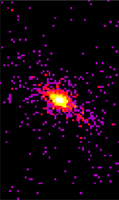June 5, 2000
CXC PR: 00-14
NASA's Chandra X-ray Observatory has shown that a large gas cloud is being blasted by X rays from the vicinity of a giant black hole which lurks in its center. The observation is of special interest because it shows the disruptive effects that a massive black hole can have over thousands of light years.
The results are being presented today by Drs. Patrick M. Ogle, Herman L. Marshall, Julia C. Lee, and Claude Canizares of the Massachusetts Institute of Technology (MIT), Cambridge, at the 196th national meeting of the American Astronomical Society in Rochester, NY. The observation also demonstrates that the searchlight beam of X rays from the black hole can be used to probe the environment around a black hole.
The galaxy NGC 4151 is located at a distance of 50 million light years in a direction just south of the Big Dipper. It is a prominent example of a class of galaxies that show unusual energetic activity in their nucleus. This activity is now known to be due to the presence of a giant black hole in the nucleus with an estimated mass 10 million times that of the Sun. As matter swirls toward the black hole, it releases a prodigious amount of energy, much of it in X rays. Previous observations showed that X rays are also coming from an enormous cloud 3000 light years across that surrounds the black hole.
The precise mirrors of Chandra allowed astronomers to make an X-ray image showing unprecedented detail of the massive cloud in the center of NGC 4151. The brightest regions in the cloud correspond to wisps that were previously observed in visible light by the Hubble Space Telescope. The shape of the cloud confirms that X rays from the black hole are collimated into a narrow beam, and illuminate only certain quadrants of the galaxy.
"The black hole is shining an X-ray searchlight which illuminates the clouds in the night sky of NGC 4151" said Ogle.
By using the High Energy Transmission Grating (HETG), astronomers were able to resolve the X-ray spectrum from the nebula surrounding the black hole into emission from its constituent elements. It was found that the gas cloud contains nitrogen, oxygen, neon, magnesium, aluminum, silicon, and iron. However, the atoms of these elements have been stripped of most of their electrons by energetic X rays coming from the center of NGC 4151. This provides direct evidence that the cloud is powered by the giant black hole which resides there. "The cloud is being thoroughly cooked by the powerful beam from the black hole," said Ogle.
In addition, the Chandra HETG spectrum reveals that portions of the cloud are moving away from us at a velocity of 800,000 mph. "We're probably seeing gas that is being blown away from the far side of the black hole by the pressure of the radiation from the black hole," Ogle said.
Chandra data were taken with the HETG in conjunction with the Advanced CCD Imaging Spectrometer (ACIS) on March 5-6, 2000. HETG was built by MIT and ACIS was built by Pennsylvania State University, University Park, and MIT.
NASA's Marshall Space Flight Center in Huntsville, Ala., manages the Chandra program. TRW, Inc., Redondo Beach, Calif., is the prime contractor for the spacecraft. The Smithsonian's Chandra X-ray Center controls science and flight operations from Cambridge, Mass.
High resolution digital versions of the X-ray image (JPG, 300 dpi TIFF ) and other information associated with this release are available on the Internet at:
MEDIA CONTACTS
Deborah Halber
Massachusetts Institute of Technology, Cambridge, MA
Phone: 617-258-9276
Steve Roy
Marshall Space Flight Center, Huntsville, AL
Phone: 256-544-6535
Dr. Wallace Tucker
Chandra X-ray Observatory Center, CfA, Cambridge, MA
Phone: 617-496-7998



